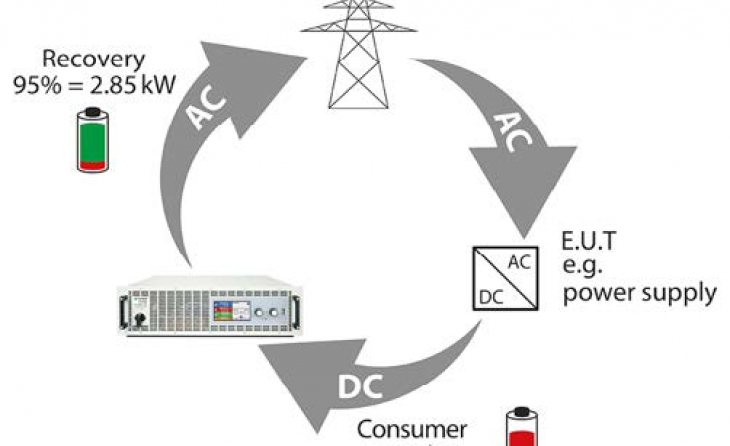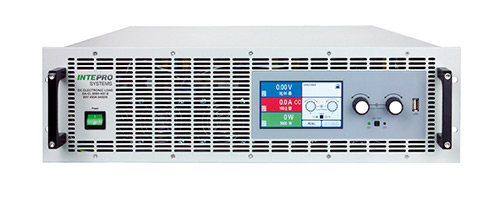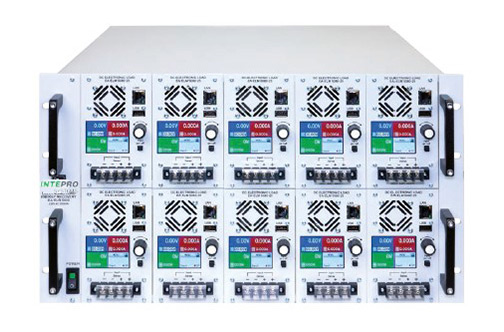Press Releases
Intepro Systems News
Electronic Loads with regenerative output cool quiet reliable and green

Load banks come in two forms: basic (essentially an array of power resistors) and electronic systems that employ active circuity to dynamically simulate changing load profiles. Load banks are often used to perform product burn-in to root out early failures (infant mortality) as part of the product’s final production testing. Electronic loads are frequently integrated into automated test systems. Test profiles are either stored in the unit or uploaded via computer interface so that the test data can be compiled for reporting or archiving purposes.
What most load banks have in common is that they take up space, consume a lot of energy, and create heat and noise. This article describes the electronic load with regenerative output, or ELR, approach to solving these issues. It also presents the typical questions engineers ask when it comes to the remarkable advantages provided by ELRs, and the answers from a manufacturer with ELRs operating in the field.
Load bank issues
In general, load banks have a number of common characteristics that can negatively impact efficiency, ease of use, the quality of the work environment and expense. The most obvious issue is energy consumption. A typical 10 kW load bank, for instance, will consume well over 10 kW of power in order to provide that function.
High power consumption leads to cooling concerns since the heat from the load must be dealt with. Small load banks might simply require the need for added air conditioning, Most loads are fan cooled, which further increases energy consumption and which can also add significantly to the ambient noise level. And for load banks that require water cooling, energy costs and significant installation expenses can be incurred.
Because of the power consumption and cooling requirements of many load banks, the units can be large, bulky and sometimes immobile.
Electronic load with regenerative output
All of the problems described above are related to the wasted energy that load banks create. But what if most of that energy could be captured? The answer is yes. How? By redirecting the power back to the utility by using an inverter stage, synchronized to the power line input.
Figure 1 illustrates how such a closed-loop system operates. Power is applied from the main to the device under test. An electronic load with regenerative output (ELR) provides the prescribed load profile and an internal micro-inverter that is used to return the power to the mains.
The results of the ELR approach are quite remarkable – with total energy consumption being reduced by up to 93%. It also has a significant effect of unit’s size, cooling requirements and audible noise. At 10kW the ELR dissipates just 700W of heat (that’s about the same as a typical hair dryer). A simple plug connection to standard line voltage is all that’s required.
A couple other benefits of dissipating just 700W of heat means smaller cooling fans, which reduce audible noise to whisper-quiet operation. Regenerative loads are also 2-3 times higher power density compared to typical air-cooled loads, which results in less rack or bench space.
The secret to the implementation of a regenerative load bank is a back-end conversion system. As shown in Fig. 2, DC energy flows into a DC-DC converter, which is tied into a DC-AC inverter (current source), and which then synchronizes with the distribution grid to recycle the energy. This technology is similar to grid-tied photovoltaic inverters (PVs).
Q&As about ELRs
Questions often arise when test engineers investigate ELR technology, since its benefits almost seem too good to be true. Intepro Systems has several models of ELR systems in production today, so we have compiled the following list of typical questions, and our responses:
Question: Is my energy meter going to spin backwards?
Answer: The ELR recovers up to 95% of the load energy and recycles it back to the facility’s AC mains network. In most cases the power recycled from the ELR is much less than the power consumed by the building’s local distribution network (Fig. 3); so, no, the meter won’t run backwards – but it will slow down considerably.
Question: Can I connect an ELR to an independent power source?
Answer: Yes, it can be connected if the facility has an independent source, such as a generator, PV system or battery, where the unit under test isn’t drawing power from the utility. In this case, the ELR is a net contributor to the local network.
Question: What happens if the utility grid drops out and the DC energy is being generated from devices that are not connected to the grid? In that case, will the ELR continue to delivery power and potentially shock someone?
Answer: No. An ELR must include an automated grid monitoring system that detects the phase voltage and frequency that is used for grid synchronization. If the grid drops out so does the ELR. This is what is referred to as “anti-islanding,” and operates under the same principal as grid-tied solar inverters. In the case of an ELR, the unit simply shuts down and waits for the operator to turn it back on.
Question: An ELR is more expensive than a standard load. Aside from the obvious advantages, how do I justify the added cost?
Answer: Field experience with ELR installations has shown that the return on investment through reduced energy costs is about three years.
Electronic loads with regenerative output provide a green solution for load testing of power supplies and other power conversion systems. They recycle upwards of 90% of the load energy.
Reliability of an ELR is high because the load dissipates very little heat, per kW, applied to the device under test. Intepro’s ELR9000 (Fig. 4) and ELR5000 Series units, for example, don’t require multiple MOSFETs or IGBTs in parallel to handle heat dissipation.


Products
Support
Company

